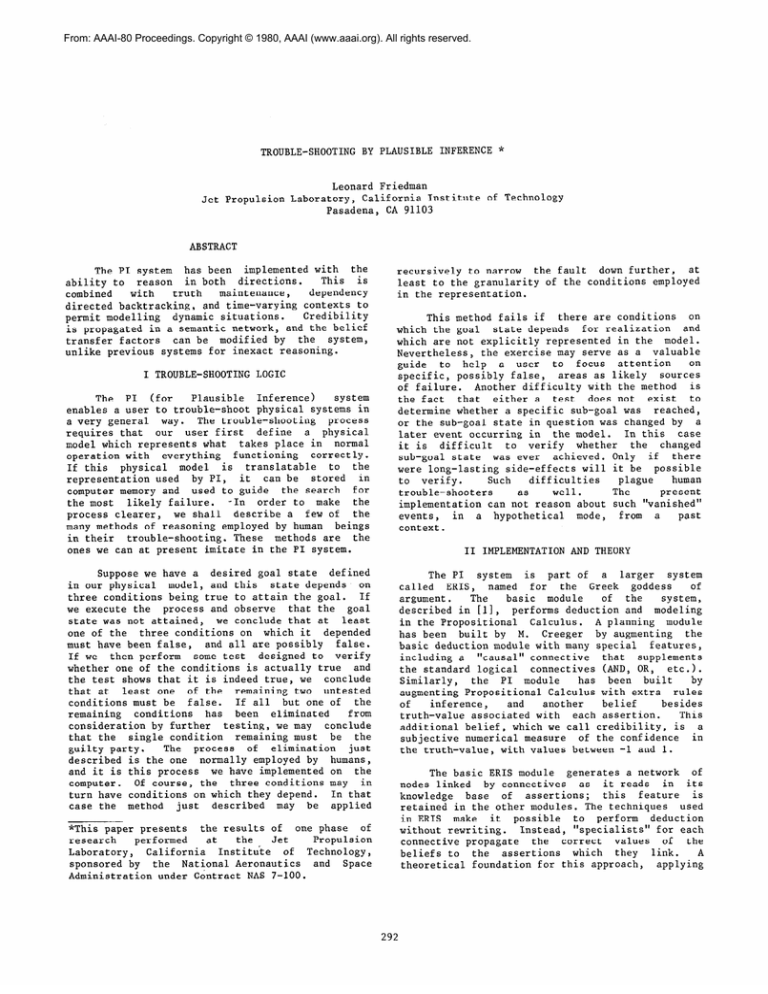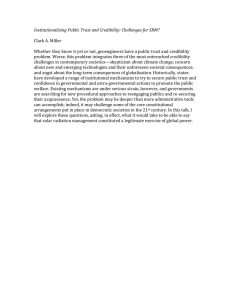
From: AAAI-80 Proceedings. Copyright © 1980, AAAI (www.aaai.org). All rights reserved.
TROUBLE-SHOOTING
Jet Propulsion
BY PLAUSIBLE
INFERENCE
Leonard Friedman
Laboratory,
California Institute
Pasadena, CA 91103
*
of Technology
ABSTRACT
The PI system
has been
implemented with
the
This
is
in both
directions.
ability to reason
dependency
maintenance,
with
truth
combined
and time-varying
contexts to
directed backtracking,
Credibility
dynamic situations.
permit modelling
is propagated in a semantic network, and the belief
system,
the
can be modified by
transfer factors
unlike previous systems for inexact reasoning.
I TROUBLE-SHOOTING
LOGIC
Inference)
system
Plausible
The
PI
(for
enables a user to trouble-shoot
physical systems in
The trouble-shooting
process
way.
a very general
our
user first
define
a physical
requires that
takes place in normal
model which represents what
everything
functioning
correctly.
operation with
to the
If this
physical
model
is translatable
by PI,
it can be
stored
in
representation
used
the search
for
computer memory and used to guide
-In order to make
the
the most
likely failure.
we shall
describe a few of the
process clearer,
beings
many methods of reasoning employed by human
trouble-shooting.
These
methods are
the
in their
ones we can at present imitate in the PI system.
the fault
down further,
at
recursively
to narrow
least to the granularity
of the conditions employed
in the representation.
on
This method fails if there are conditions
state depends
for realization
and
which the goal
which are not explicitly represented
in the model.
the exercise may serve as a valuable
Nevertheless,
attention
on
to focus
to help
a user
guide
sources
areas as likely
specific, possibly false,
Another difficulty with the method
is
of failure.
does not
exist
to
either a test
that
the fact
determine whether a specific sub-goal was
reached,
or the sub-goal state in question was changed by
a
In this
case
later event occurring in the model.
changed
whether
the
it is difficult
to verify
achieved. Only
if there
sub-goal state
was ever
were long-lasting
side-effects will it be possible
human
difficulties
plague
Such
to verify.
present
as
well.
The
trouble-shooters
implementation
can not reason about such "vanished"
from
a
past
events,
in a hypothetical
mode,
context.
II IMPLEMENTATION
Suppose we have a desired goal state
defined
model, and this
state depends
on
in our physical
three conditions being true to attain the goal.
If
we execute the
process and observe
that the
goal
we conclude that at
least
state was not attained,
three conditions on which it depended
one of the
and all are possibly
false.
must have been false,
some test
designed to verify
If we
then perform
and
whether one of the conditions is actually true
conclude
the test shows that it is indeed true, we
that at
least one
of the
remaining two untested
conditions must be
false.
If all
but one of
the
from
remaining
conditions
has
been
eliminated
testing, we may
conclude
consideration
by further
remaining must
be
the
single condition
that the
just
The
process
of elimination
guilty party.
described is the one
normally employed by humans,
we have implemented on
the
and it is this process
three conditions may
in
Of course, the
computer.
In that
turn have conditions on which they depend.
case the method
just
described
may
be
applied
AND THEORY
system
The PI
system
is part of a larger
the Greek
goddess
of
called
ERIS,
named
for
basic
module
of
the
system,
argument.
The
described in [ll,
performs deduction and modeling
in the Propositional
Calculus.
A planning
module
Creeger
by augmenting
the
has been
built by M.
basic deduction module with many special
features,
that
supplements
including a "causal" connective
connectives
(AND, OR,
etc.).
the standard logical
the
PI module
has
been
built
by
Similarly,
rules
augmenting Propositional
Calculus with extra
belief
besides
inference,
and
another
of
This
truth-value associated with
each assertion.
is a
additional belief, which we call credibility,
of the confidence
in
subjective numerical measure
the truth-value, with values between -1 and 1.
The basic ERIS module
generates a network
of
nodes linked
by connectives
as
it reads
in its
knowledge
base
of assertions;
this
feature
is
retained in the other modules. The techniques
used
it possible
to perform
deduction
in ERIS
make
for each
Instead, "specialists"
without rewriting.
values
of the
correct
the
connective propagate
beliefs to
the
assertions
which
they
link.
A
theoretical
foundation for this approach,
aw lying
the results of one phase
of
*This paper presents
Propulsion
the
Jet
performed
at
research
Laboratory,
California
Institute
of Technology,
and
Space
the National Aeronautics
sponsored by
Administration
under Contract NAS 7-100.
292
transfer between arbitrary logical expressions
been worked out to
specify exactly the process
Credibility
propagation
through
the
net.
calculus is described
in
[31, and
is based
equations employed in MYCIN [41.
both to Propositional
Calculus
and First
Order
Predicate Calculus,
is given
by
the method
of
Analytic
Tableaux"
Because
rewriting
is
[Zl.
totally
avoided,
inference,
planning,
model-revision,
and
dependency-directed
backtracking
can
be
performed
in
single
a
integrated system.
Al(Q(
The basic
quantities controlling
propagation
between antecedents and consequents in
implication
are transfer
factors or DELTAl's, and
there
are
four for each
antecedent/consequent
pair, one
for
(See Fig. 1) Both MYCIN and PROSPECTOR
each mode.
are limited to a single reasoning mode and transfer
factor
for
each
implication
and
use
a static
that
is specified
by
transfer factor
structure
human
"experts".
The
PI
system,
in
trouble
shooting,
recalculates
appropriate
the
transfer
factors on
the
basis of
incoming
evidence.
In
addition to a dynamic transfer factor structure, PI
also incorporates
the use of default values for the
transfer factors in trouble-shooting
when the users
do not have better information.
PI 2)
I
:T; +.5
:F; -.5
III APPLICATION
Plausible Inference
introduces two rules
of
inference besides Modus
Ponens and Modus
Tollens,
called the Method of Confirmation
and the Method of
Denial.
These extra
modes permit the
propagation
of truth values, true or false, even in directions
forbidden
Propositional
Calculus.
bY
Simultaneously,
the
associated
credibilities
are
propagated through
the
net,
employing
all
four
modes as appropriate.
A calculus of Credibility
)
-“.“yT)
GROUND ANTENNA
RECEIVING
-0.001
TRANSMIT
SIGNAL
RSS POWER
ON
-0.001
SIGNAL
(3
RECEIVED
77
CORRECT
DATA MODE
SIGNAL
TRANSMITTED
Fig. 2
Plan
EXAMPLE
Our example of automated trouble-shooting
uses
a toy case
the application
domain,
selected from
the mission
spacecraft.
control
of
It
is
a
simplified representation
of
transmission
signal
from a space craft
to Earth.
The
desired
goal
state is "Signal Received"
from the
SIC.
Fig
2
shows a plan to accomplish
this which
has
been
generated by the ERIS
planner.
The user
supplies
three basic
"action CAUSES
state" relations:
(1)
"Ground
Antenna
Receiving"
CAUSES
"Signal
Received",
"Point
SIC"
CAUSES
"Pointed
(2)
Correctly",
and
(3)
"Transmit
Signal"
CAUSES
"Signal Transmitted".
The
pre-conditions
for
the
first relation are the
end states achieved in the
Arcs link antecedent/consequent
in implication
Fig. 1 Transfer Factors in a Semantic Net
S/C POINTED
CORRECTLY
has
of
The
on
for Command
293
Sequence
Generation
credibilities
entered on the branching lines. These
are
subjective
measures
of
the
likelihood
of
failure of the respective events to which they lead
given that
the
state
which depends
on
them
is
false.
Thus,
for
"Signal
Received",
"Pointed
Correctly" has an a priori credibility
associated
with false of -.7, "Signal Transmitted"
a value
of
-.3 and "Point space craft" a value of -.OOl .
When we start,
the assumption
is that
every
state is true (at the
appropriate time)
with
a
credibility of 1.0
(equivalent to certainty).
At
the next stage,
when all we know is that
"Signal
Received" is false, the a priori credibilities
are
assigned to all the states.
If we used the default
mode, credibility
would
be assigned
equally;
i.
e., for two
events, each would
get .5, for
three
.33, for
four
.25, etc.
Whenever
an event
is
eliminated as true, the remaining credibilities
are
raised by
an empirical formula
that
reflects
a
reasonable sharing
of suspicion,
based either
on
the a priori splits
or an equal partition.
Thus,
in our example, "Starmap
Accurate" went from
true
(cred
1.0)
to Possibly
False
(cred
-.007)
to
Possibly False (cred -.Ol> to False (cred -1.0).
"In
second and
third.
In effect we
are saying,
order for
an action
to achieve
the
goal
state
certain pre-conditions
must be
true.
In order
to
make those pre-conditions
true certain actions will
cause them which
may also
have pre-conditions
to
succeed".
Thus complex sequences may be built
up.
The ERIS planner links the basic strategies in the
manner shown,
using the
pre-conditions
as hooks.
It then
collects
the
actions
in a list,
and
supplies that list as the desired command sequence.
The
plan
generated
in
this
way
is
a
descriptive
model
of
the
signal
transmission
process
and
constitutes
our
trouble-shooting
knowledge base.
The propagation
of beliefs
that
takes place with the CAUSES connective is identical
to the
belief propagations
of an
implication
as
defined in
[3], although
the
timing
of belief
propagation
of CAUSES are different.
We define the
belief propagation-equivalent
implication form
of
the
CAUSES
relation
as
(IMPLIES
(AND
action
precondition1
..
preconditionN)
goal-state).
At
the start, the assumption
is made that all
states
are true.
This,
in a simplified
way,
describes
the
operation of PI in trouble-shooting
using reasoning
by Plausible Inference.
Of course, humans
employ
many other
methods in trouble shooting,
such
as
analogy.
For
example,
a person
may
say
"This
problem resembles
one
I encountered
in another
area. Maybe it has the same cause I deduced
then."
By such techniques, humans can often vector in on a
problem, bypassing
step-by-step
elimination.
We
hope
to
implement
some
of
these
techniques
eventually.
Suppose that the sequence is executed and
the
ground station fails to receive the signal.
Then
"Signal Received" is false, and this can be entered
into the data base. The
effects of this change
of
belief are propagated
through the data
base by
a
modified Modus Tollens,
making all
the events
on
which "Signal Received" depends Possibly-False
(or
PF).
If a test
is then
performed by
the human
controllers
like
causing
the s/c
to roll
while
transmitting,
and a signal
is received during
the
roll, we may conclude that the action "Point
space
craft" worked,
"Signal Transmitted"
is true,
and
"Ground
Antenna
Receiving"
has
been
verified.
Inputting these facts into the data base causes the
PI system to do two things:
(1)
References
111 Thompson
A.
M.,
"Logical
Support
in
a
Time-Varying
Model", in __I_-Lecture Notes in Computer
Science,
Springer-Verlag,
Berlin,
1980.
Fifth
Conf.
on Automated Deduction, July 8-11, Les Arcs,
Savoie, France.
Those
preconditions
required
by
"Signal
Transmitted"
are changed from PF to T by Modus
Ponens. (Possibly False to True)
(2) "Pointed Correctly"
is changed to False,
F,
rather than PF. In addition, the
PI
system
raises
the
credibility of failure
for those
events
on which "Pointed Correctly" depends.
Their
truth
value
remains
Possibly
False
because there are multiple possibilities.
Smullyan
[21
Springer-Verlag,
R.
M,
First-Order
Berlin, 1968
Logic,
[3] Friedman L., "Reasoning by Plausible Inference"
in
Lecture
Notes
*
Computer
Science
Springer-Verlag,
Berlin, 580.
Proc.
Fifth
Conf.
on Automated
Deduction,
July
8-11,
Les
Arcs,
Savoie, France.
If one of these latter
events is shown to be
true by testing, the remaining one may be the
only
possibility
left.
For example,
if the Sun
Sensor
and Canopus Sensor can be shown to work, and
their
truth status
is input,
the system
will
conclude
that the Starmap must be at fault, even though
the
a priori
credibility
of
such
a mistake
was
extremely low.
[41 Shortliffe E. H. and
Buchanan B. G., "A Model
of Inexact Reasoning
in Medicine" , Math.
Biosci.
351-379,
1975.
Also
chapt.
4
of
23,
PP.
Computer-Based
Medical
Consultations:
MYCIN,
Elsevier, New York, 1976.
How the credibilities
change at various stages
of operation
can be
described now.
At the
start
there
are
two
possibilities:
either
a
priori
credibilities
may
be
entered
or
default
credibilities
generated.
Figure
2 shows a priori
294





